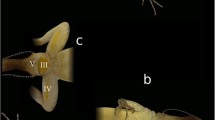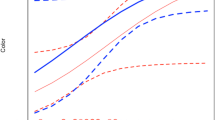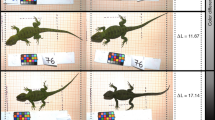Abstract
Integrative behavioral studies show that the interplay between individual physiology and social behavior influences the ecology of the species, ultimately affecting individual fitness. Particularly in lizards, color polymorphism is associated with differential behaviors and reproductive strategies, which are evident in mature males during the mating season. Dominant males generally have greater endurance, higher body temperature, and larger bodies than submissive males, so they can acquire and defend larger territories and have greater access to females for mating. We studied whether the color morphs observed in males of one of the world’s southernmost reptiles, Liolaemus sarmientoi, are related to behavioral variation during agonistic interactions, thermal physiology, morphology, and/or locomotor stamina. Liolaemus sarmientoi males exhibit three color morphs: red (RR), red–yellow (RY), and yellow (YY). These lizards exhibit subtle behavioral displays and we did not observe stamina differences among morphs. However, we found that RR males are more aggressive than YY males during agonistic encounters. In addition, greater body temperature change during trials, higher field body temperatures, and greater head sizes of RR males compared to RY or YY indicate that RR is a dominant morph, which may influence their ability to acquire and defend territory and tactics for achieving reproductive success.



Similar content being viewed by others
References
Abalos J, Pérez i de Lanuza G, Carazo P, Font E (2016) The role of male coloration in the outcome of staged contests in the European common wall lizard (Podarcis muralis). Behaviour 153:607–631
Abdala CS, Quinteros AS (2014) Los últimos 30 años de estudios de la familia de lagartijas más diversa de Argentina. Actualización taxonómica y sistemática de Liolaemidae. Cuadernos de Herpetología 28:55–82
Abdala CS, Acosta JL, Acosta JC et al (2012) Categorización del estado de conservación de los lagartos de la República Argentina. Cuadernos de Herpetología 26:215–248
Anderson RA, McBrayer LD, Herrel A (2008) Bite force in vertebrates: opportunities and caveats for use of a nonpareil whole-animal performance measure. Biol J Linn Soc 98:709–720
Bastiaans E, Morinaga G, Gamaliel Castañeda Gaytán J, Marshall JC, Sinervo B (2013) Male aggression varies with throat color in 2 distinct population of the mesquite lizard. Behav Ecol 24(4):968–981
Bauwens D, Hertz PE, Castilla AM (1996) Thermoregulation in a lacertid lizard: the relative contributions of distinct behavioral mechanisms. Ecology 77:1818–1830
Bolton PE, Rollins LE, Griffith SC (2016) Colour polymorphism is likely to be disadvantageous to some populations and species due to genetic architecture and morph interactions. Mol Ecol 25:2713–2718
Breitman MF, Minoli I, Avila LJ, Medina CD, Sites JW Jr, Morando M (2014) Lagartijas de la provincia de Santa Cruz, Argentina: distribución geográfica, diversidad genética y estado de conservación. Cuadernos de Herpetología 28(2):83–110
Calsbeek R, Sinervo B (2007) Correlational selection on lay date and life history traits: experimental manipulations of territory and nest site quality. Evolution 61(5):1071–1083
Calsbeek R, Alonzo SH, Zamudio K, Sinervo B (2001) Sexual selection and alternative mating behaviours generate demographic stochasticity in small populations. Proc R Soc B Biol Sci 269:157–164
Calsbeek B, Hasselquist D, Clobert J (2010) Multivariate phenotypes and the potential for alternative phenotypic optima in wall lizard (Podarcis muralis) ventral colour morphs. J Evolutionary Biol 23(6):1138–1147
Carpenter GC (1995) Modeling dominance: the influence of size, coloration, and experience on dominance relations in tree lizards (Urosaurus ornatus). Herpetol Monogr 9:88–101
Cei JM (1986) Reptiles del Centro-oeste y Sur de la Argentina. Herpetofauna de las Zonas Aridas y Semiáridas, 1st edn. Museo Regionale di Scienze Naturali, Torino
Comendant T, Sinervo B, Svensson EI, Wingfield J (2003) Social competition, corticosterone and survival in female lizard morphs. J Evol Biol 16(5):948–955
Corl A, Davis AR, Kuchta SR, Comendant T, Sinervo B (2010) Alternative mating strategies and the evolution of sexual size dimorphism in the side-blotched lizard, Uta stansburiana: a population-level comparative analysis. Evolution 64:79–96
Cox RM, John-Adler HB (2005) Testosterone has opposite effects on male growth in lizards (Sceloporus spp.) with opposite patterns of sexual size dimorphism. J Exp Biol 208:4679–4687
Fernández JB, Smith J Jr, Scolaro A, Ibargüengoytía NR (2011) Performance and thermal sensitivity of the southernmost lizards in the world, Liolaemus sarmientoi and Liolaemus magellanicus. J Therm Biol 36:15–22
Fernández JB, Medina SM, Kubisch EL, Manero AA, Scolaro JA, Ibargüengoytía NR (2015) Female reproductive biology of the lizards Liolaemus sarmientoi and L. magellanicus from the southern end of the world. Herpetol J 25:101–108
Fernández JB, Medina SM, Kubisch EL, Scolaro JA, Ibargüengoytía NR (2017) Reproductive strategies in males of the world’s southernmost lizards. Integr Zool. https://doi.org/10.1111/1749-4877.12224
Font E, Carazo P, Pérez i de Lanuza G, Barbosa D (2010) Comportamiento y comunicación animal: ¿Qué nos enseñan los lagartos? Acta Zool Lilloana 54(12):11–34
Forsman A (2016) Is colour polymorphism advantageous to populations and species? Mol Ecol 25(12):2693–2698
Forsman A, Ahnesjö J, Caesar S, Karlsson M (2008) A model of ecological and evolutionary consequences of color polymorphism. Ecology 89(1):34–40
Fuentes ER (1976) Ecological convergence of lizard communities in Chile and California. Ecology 57:3–17
Galeotti P, Sacchi R, Pellitteri-Rosa D, Bellati A, Cocca W, Gentilli A, Scali S, Fasola M (2013) Colour polymorphism and alternative breeding strategies: effects of parent’s colour morph on fitness traits in the common wall lizard. Evol Biol 40(3):385–394
Halloy M (2012) Visual display variations in neotropical lizards, Liolaemus quilmes (Iguania: Liolaemidae): relation to sex and season. Herpetol J 22:265–268
Halloy M, Robles C, Salica MJ, Semhan R, Juárez Heredia V, Vicente N (2013) Estudios de comportamiento y ecología de lagartijas de los géneros Liolaemus y Phymaturus. (Iguania: Liolaemini). Cuadernos de Herpetología 27(1):15–26
Hamilton DG, Whiting MJ, Pryke SR (2013) Fiery frills: carotenoid-based coloration predicts contest success in frillneck lizards. Behav Ecol 24(5):1138–1149
Healey M, Uller T, Olsson M (2007) Seeing red: morph-specific contest success and survival rates in a colour-polymorphic agamid lizard. Anim Behav 74(2):337–341
Herrel A, Aerts P, De Vree F (1998) Ecomorphology of the lizard feeding apparatus: a modeling approach. Neth J Zool 48:1–25
Herrel A, De Grauw E, Lemos-Espinal JA (2001) Head shape and bite performance in Xenosaurid lizards. J Exp Zool 290:101–107
Herrel A, Vanhooydonck B, Van Damme R (2004) Omnivory in lacertid lizards: adaptive evolution or constraint? J Evol Biol 17:974–984
Hertz PE, Huey R, Stevenson RD (1993) Evaluating Temperature regulation by field-active ectotherms: the fallacy of the inappropriate question. Am Nat 142:796–818
Huyghe K, Vanhooydonck B, Herrel A, Tadić Z, Van Damme R (2007) Morphology, performance, behavior and ecology of three color morphs in males of the lizard Podarcis melisellensis. Integr Comp Biol 47(2):211–220
Huyghe K, Husak JF, Herrel A, Tadić Z, Moore IT, Van Damme R, Vanhooydonck B (2009) Relationships between hormones, physiological performance and immunocompetence in a color-polymorphic lizard species, Podarcis melisellensis. Horm Behav 55(4):488–494
Huyghe K, Vanhooydonck B, Herrel A, Tadić Z, Van Damme R (2012) Female lizards ignore the sweet scent of success: male characteristics implicated in female mate preference. Zoology 115(4):217–222
Ibargüengoytía NR (2008) Estrategias reproductivas en reptiles. In: Vidal MA, Labra A (eds) Herpetología de Chile. Science, Santiago de Chile, pp 392–425
Ibargüengoytía NR, Medina SM, Fernández JB, Gutiérrez JA, Tappari F, Scolaro A (2010) Thermal biology of the southernmost lizards in the world: Liolaemus sarmientoi and Liolaemus magellanicus from Patagonia, Argentina. J Therm Biol 35:21–27
Kubisch EL, Corbalán V, Ibargüengoytía NR, Sinervo B (2016) Local extinction risk of three species of lizard from Patagonia as a result of global warming. Can J Zool 94:49–59
Labra A, Carazo P, Desfilis E, Font E (2007) Agonistic interactions in a Liolaemus lizard: structure of head bob displays. Herpetologica 63(1):11–18
Langkilde T, Shine R (2006) How much stress do researchers inflict on their study animals? A case study using a scincid lizard, Eulamprus heatwolei. J Exp Biol 209:1035–1043
Lattanzio MS, Miles DB (2016) Trophic niche divergence among colour morphs that exhibit alternative mating tactics. R Soc Open Sci 3:150531
Lombo JG (1989) Caracterización de los patrones de conducta agresiva territorial del lagarto de la sabana de Bogotá Phenacosaurus heterodermus (Sauria: Iguanidae). Caldasia 16(76):112–118
Martins EP, Labra A, Halloy M, Thompson JT (2004) Large-scale patterns of signal evolution: an interspecific study of Liolaemus lizard headbob displays. Anim Behav 68(3):453–463
Medina M, Ibargüengoytía NR (2010) How do viviparous and oviparous lizards reproduce in Patagonia? A comparative study of three species of Liolaemus. J Arid Environ 74:1024–1032
Medina M, Gutierrez J, Scolaro A, Ibargüengoytía NR (2009) Thermal responses to environmental constraints in two populations of the oviparous lizard Liolaemus bibronii in Patagonia, Argentina. J Therm Biol 37:579–586
Miles DB, Sinervo B, Hazard LC, Svensson EI, Costa D (2007) Relating endocrinology, physiology and behaviour using species with alternative mating strategies. Func Ecol 21(4):653–665
Mills SC, Hazard L, Lancaster L, Mappes T, Miles D, Oksanen TA, Sinervo B (2008) Gonadotropin hormone modulation of testosterone, immune function, performance, and behavioral trade-offs among male morphs of the lizard Uta stansburiana. Am Nat 171:339–357
Moore MC, Thompson CW, Marler CA (1991) Reciprocal changes in corticosterone and testosterone levels following acute and chronic handling stress in the tree lizard Urosaurus ornatus. Gen Comp Endocr 81:217–226
Olsson M, Healey M, Astheimer L (2007) Afternoon T: testosterone level is higher in red than yellow male polychromatic lizards. Physiol Behav 91(5):531–534
Olsson M, Andersson S, Wapstra E (2011) UV-Deprived coloration reduces success in mate acquisition in male sand lizards (Lacerta agilis). Plos One 6(5):e19360
Pérez i de Lanuza G, Font E (2007) Ultraviolet reflectance of male nuptial colouration in sand lizards (Lacerta agilis) from the Pyrenees. Amphibia Reptil 28(3):438–443
Perry G, LeVering K, Girard I, Garland T (2004) Locomotor performance and social dominance in male Anolis cristatellus. Anim Behav 67(1):37–47
Pizzatto L, Dubey S (2012) Colour-polymorphic snake species are older. Biol J Linn Soc 107(1):210–218
Robson MA, Miles DB (2000) Locomotor performance and dominance in male tree lizards, Urosaurus ornatus. Funct Ecol 14(3):338–344
Sacchi R, Pupin F, Gentilli A, Rubolini D, Scali S, Fasola M, Galeotti P (2009) Male–male combats in a polymorphic lizard: residency and size, but not color, affect fighting rules and contest outcome. Aggress Behav 35(3):274–283
Scali S, Sacchi R, Mangiacotti M, Pupin F, Gentill A, Zucchi C, Sannolo M, Pavesi M, Zuffi MA (2016) Does a polymorphic species have a ‘polymorphic’ diet? A case study from a lacertid lizard. Biol J Linn Soc 117(3):492–502
Scolaro A (2005) Reptiles Patagónicos: Sur. Guía de Campo. Universidad Nacional de la Patagonia, Trelew
Scolaro JA, Cei JM (1997) Systematic status and relationships of Liolaemus species of the archeforus and kingii groups: morphological and taxonumerical approach (Reptilia: Tropiduridae. Bolletin del Museo Regionale di Scienze Naturali Torino 15(2):369–406
Shine R, Bull JJ (1979) The evolution of live-bearing in lizards and snakes. Am Nat 1979:905–923
Sinervo B (2001) Runway social games, genetic cycles driven by alternative male and female strategies, and the origin of morphs. Genetica 112:417–434
Sinervo B, Calsbeek R (2006) The developmental, physiological, neural, and genetical causes and consequences of frequency-dependent selection in the wild. Annu Rev Ecol Evol Syst 37:581–610
Sinervo B, Clobert J (2003) Morphs, dispersal, genetic similarity and the evolution of cooperation. Science 300:1949–1951
Sinervo B, Huey RB (1990) Allometric engineering: an experimental test of the causes of interpopulational differences in performance. Science 248(4959):1106–1110
Sinervo B, Lively CM (1996) The rock-paper-scissors game and the evolution of alternative male reproductive strategies. Nature 380:240–243
Sinervo B, Miles DB (2011) Hormones and behavior of reptiles. In: Norris DO, Lopez KH (eds) Hormones and reproduction of vertebrates. Academic, London, pp 215–246
Sinervo B, Svensson E (2002) Correlational selection and the evolution of genomic architecture. Heredity 89:329–338
Sinervo B, Zamudio KR (2001) The evolution of alternative reproductive strategies: fitness differential, heritability, and genetic correlation between the sexes. J Hered 92(2):198–205
Sinervo B, Miles DB, Frankino WA, Klukowski M, De Nardo DF (2000a) Testosterone, endurance, and Darwinian fitness: natural and sexual selection on the physiological bases of alternative male behaviors in side-blotched lizards. Horm Behav 38:222–233
Sinervo B, Svensson E, Comendant T (2000b) Density cycles and an offspring quantity and quality game driven by natural selection. Nature 406:985–988
Sinervo B, Bleay C, Adamopoulou C (2001) Social causes of correlational selection and the resolution of a heritable throat color polymorphism in a lizard. Evolution 55(10):2040–2052
Sinervo B, Chaine A, Clobert J, Calsbeek R, Hazard L, Lancaster L, McAam AG, Alonzo S, Corrigan G, Hochberg ME (2006) Self-recognition, color signals, and cycles of greenbeard mutualism and altruism. Proc Natl Acad Sci USA 103(19):7372–7377
Smith LC, John-Alder HB (1999) Seasonal specificity of hormonal, behavioral, and coloration responses to within-and between-sex encounters in male lizards (Sceloporus undulatus). Horm Behav 36(1):39–52
Soto J, Vázquez M (2001) Las condiciones climáticas de la provincia de Santa Cruz. In: Soto J, Vázquez M (eds) El gran libro de la provincia de Santa Cruz. Ed. Oriente-Alfa Centro literario, Madrid, p. 651
Svensson EI (2017) Back to basics: using colour polymorphisms to study evolutionary processes. Molec Ecol. https://doi.org/10.1111/mec.14025
Svensson E, Sinervo B, Comendant T (2001) Condition, genotype-by-environment interaction, and correlational selection in lizard life-history morphs. Evolution 55:2053–2069
Takahashi Y, Kagawa K, Svensson EI, Kawata M (2014) Evolution of increased phenotypic diversity enhances population performance by reducing sexual harassment in damselflies. Nature Commun 5:4468
Tokarz RR (1985) Body size as a factor determining dominance in staged agonistic encounters between male brown anoles (Anolis sagrei). Anim Behav 33(3):746–753
Vanhooydonck B, Cruz FB, Abdala CS, Moreno Azócar DL, Bonino MF, Herrel A (2010) Sex-specific evolution of bite performance in Liolaemus lizards (Iguania: Liolaemidae): the battle of the sexes. Bio J Linn Soc 101:461–475
Vercken E, Massot M, Sinervo B, Clobert J (2007) Colour variation and alternative reproductive strategies in females of the common lizard Lacerta vivipara. J Evol Biol 20(1):221–232
Vercken E, Sinervo B, Clobert J (2008) Colour variation in female common lizards: why we should speak of morphs, a reply to Cote et al. J Evol Biol 21(4):1160–1164
Vercken E, Clobert J, Sinervo B (2010) Frequency-dependent reproductive success in female common lizards: a real-life hawk–dove–bully game? Oecologia 162(1):49–58
Weiss SL, Moore MC (2004) Activation of aggressive behavior by progesterone and testosterone in male tree lizards, Urosaurus ornatus. Gen Comp Endocr 136(2):282–288
While GM, Isaksson C, McEvoy J, Sinn DL, Komdeur J, Wapstra E, Groothuis TG (2010) Repeatable intra-individual variation in plasma testosterone concentration and its sex-specific link to aggression in a social lizard. Horm Behav 58(2):208–213
Whiting MJ (1999) When to be neighbourly: differential agonistic responses in the lizard Platysaurus broadleyi. Behav Ecol Sociobiol 46(3):210–214
Whiting MJ, Stuart-Fox DM, O’Connor D, Firth D, Bennett NC, Blomberg SP (2006) Ultraviolet signals ultra-aggression in a lizard. Anim Behav 72(2):353–363
Yewers MSC, Pryke S, Stuart-Fox D (2016) Behavioural differences across contexts may indicate morph-specific strategies in the lizard Ctenophorus decresii. Anim Behav 111:329–339
Zajitschek SR, Zajitschek F, Miles DB, Clobert J (2012) The effect of coloration and temperature on sprint performance in male and female wall lizards. Biol J Linn Soc 107(3):573–582
Zamudio KR, Sinervo B (2000) Polygyny, mate-guarding, and posthumous fertilization as alternative male mating strategies. Proc Natl Acad Sci 97(26):14427–14432
Acknowledgements
We thank Mr. P. J. Rute, Director of Plantas Estables, Santa Cruz Province for providing a place to stay during captures and experiments. We also thank M. Cabral and L. Rodriguez for providing the access to the study site, and E. Kubisch for his helpful comments on statistical analyses. Research permits (N° 09/09 and 013/2012) were obtained from the Wildlife Delegation of Santa Cruz Province, Argentina. This research was supported by the Universidad Nacional del Comahue (CRUB) and the Argentinean Consejo Nacional de Investigaciones Científicas y Técnicas (CONICET, PIP 100271 and RD2702-12), Fondo para la Investigación Científica y Tecnológica (FONCyT) PICT-20143100, and by funding to Sinervo by NSF (IOS-1022031, EF-1241848).
Author information
Authors and Affiliations
Corresponding author
Ethics declarations
Conflict of interest
The authors declare that they have no conflict of interest.
Ethical statement
All applicable international, national and/or institutional guidelines for the care and use of animals were followed. All procedures performed in studies involving animals were in accordance with the ethical standards of the institution or practice at which the studies were conducted. This article does not contain any studies with human participants performed by any of the authors.
Informed consent
Informed consent was not required.
Rights and permissions
About this article
Cite this article
Fernández, J.B., Bastiaans, E., Medina, M. et al. Behavioral and physiological polymorphism in males of the austral lizard Liolaemus sarmientoi . J Comp Physiol A 204, 219–230 (2018). https://doi.org/10.1007/s00359-017-1233-1
Received:
Revised:
Accepted:
Published:
Issue Date:
DOI: https://doi.org/10.1007/s00359-017-1233-1




